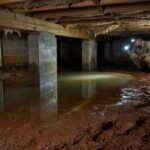Essential Guide to Foundation Repair: Protecting Your Home from Structural Damage
When it comes to home ownership, there’s a lot more that goes into maintaining your property than just keeping the lawn mowed and the gutters clean. One of the most critical aspects of home maintenance is also one of the least visible—your foundation. A compromised foundation can lead to all sorts of structural headaches, and trust us, you don’t want to discover that you have a problem when it’s too late. This essential guide will unravel the mysteries of foundation repair, helping you understand how to protect your castle (yes, even if it’s a modest abode) from potential structural damage.
Understanding Your Foundation
First things first: what exactly is a foundation? Think of it as the sturdy base upon which your entire home rests. It bears the weight of your house and transfers that load to the ground. Foundations can be made from concrete slabs, crawl spaces, or basements, and each type has its quirks and considerations.
Why Foundations Fail
Now, let’s get to the meat of the matter—why do foundations fail? Foundations can buckle under pressure from various sources. Here are some common culprits:
1. **Soil Issues**: The type of soil beneath your home plays a significant role in foundation stability. Clay-rich soils may expand and contract with moisture changes, leading to shifting foundations. Sandy soils might wash away during heavy rain, leaving your foundation high and dry—literally.
2. **Poor Drainage**: If water is pooling around your foundation instead of being directed away, you could be dealing with a future disaster. Waterlogged soil exerts pressure on the foundation and can eventually lead to cracks and settling.
3. **Tree Roots**: While trees provide shade and beauty to your landscape, their roots can wreak havoc on your foundation if they grow too close. The quest for water can lead roots to invade and disrupt the soil surrounding your home.
4. **Heavy Loads**: If you’ve recently added an addition to your home or installed a swimming pool, you may be putting extra stress on your foundation. Make sure your foundation is up to the task!
5. **Age of the Home**: Let’s face it, nothing lasts forever. Older homes may have foundations that were not built to modern standards, leading to an increased risk of issues over time.
Signs of Foundation Problems
Keep an eye out for the early warning signs that your foundation might be crying for help. Not every crack in your wall means your house is about to tumble down like a house of cards, but some indicators should trigger concern:
– **Cracks in Walls**: Small hairline cracks are generally nothing to worry about, but wide cracks (over 1/8 inch) can indicate shifting or settling.
– **Doors and Windows Sticking**: If your doors and windows suddenly start playing hard to get, it could mean your foundation is settling or shifting out of alignment.
– **Uneven Floors**: If you find yourself rolling marbles across the living room floor or feel like you’re practicing yoga on a tilt-a-whirl, it may be time to investigate the foundation.
– **Gaps Around Window Frames**: Have you noticed gaps between your window frames and the wall? This could be a red flag signaling foundation issues.
– **Bowing Walls**: If your interior walls start to resemble a funhouse mirror, it’s definitely time to call in the pros.
Steps to Repairing Your Foundation
If you’ve noticed any of the signs mentioned above, don’t panic! Foundation problems can often be resolved with the right approach and expertise. Here’s a step-by-step guide on what to expect during the foundation repair process:
1. **Hire a Professional Inspector**: Before you take any drastic measures, it’s crucial to have a professional assess the situation. A certified foundation inspector can identify the scope of the problem and recommend solutions tailored to your specific needs.
2. **Choose the Right Repair Method**: There’s no one-size-fits-all solution when it comes to foundation repair. Common methods include:
– **Piering**: This method involves installing piers deep into stable soil or bedrock to lift and stabilize the foundation.
– **Slabjacking**: If your foundation is a concrete slab, this method injects materials beneath the slab to raise it back into place.
– **Wall Anchors**: For bowing walls, wall anchors can be installed to pull the wall back into a straight position.
– **Drainage Solutions**: To prevent future problems, installing drainage systems, like French drains, could be necessary to redirect water away from your foundation.
3. **Prepare for Construction**: Foundation repairs can be noisy and messy, so if you have pets or young children, consider making arrangements for them to be elsewhere during the work. Plus, it gives you a great excuse to escape for a mini vacation!
4. **Monitor the Repairs**: After the repair work is completed, keep an eye on your home. Look for any new signs of movement or additional issues. Remember, foundation repair is not a “set it and forget it” kind of deal.
5. **Maintain Your Foundation**: Protect your newly repaired foundation by ensuring proper drainage, maintaining consistent watering of your lawn (not too much!), and keeping tree roots at bay. Regular inspections can help catch any potential issues before they escalate.
Cost of Foundation Repair
Let’s talk numbers, shall we? The cost of foundation repair can vary widely based on several factors, including the severity of the damage, the methods employed, and geographic location. On average, homeowners can expect to pay anywhere from $2,000 to $7,000 for simple repairs, while major structural issues can run upwards of $25,000 or more. Ouch! That said, investing in your foundation is much cheaper than the alternative of waiting until it becomes a catastrophic issue.
DIY vs. Hiring a Pro
You might think, “Hey, I’m a handy individual. Why not try repairing my foundation myself?” While it’s noble to want to save money, foundation repairs are typically best left to the professionals. Not only do they possess the necessary skills and tools, but they also understand local building codes and can ensure that the work is done correctly.
However, you can DIY some preventive measures, like:
– **Regular Landscaping Maintenance:** Keep plants and trees at a safe distance from your foundation.
– **Proper Gutters and Downspouts:** Ensure that water is redirected away from your foundation.
– **Soil Grading:** Ensure that the soil slopes away from your home’s foundation.
Conclusion
In conclusion, a strong foundation is the backbone of your home. Ignoring foundation issues can lead to more severe structural damage and costly repairs down the line. By understanding the signs of foundation problems, knowing how to respond, and taking preventative measures, you can protect your home from the perils of structural damage. So go ahead—give your foundation the care it deserves. After all, it’s the unsung hero of your home’s structure, working silently day in and day out to keep everything upright and intact. Give it a little love, and it will reward you by continuing to bear the weight of your life’s greatest moments!


